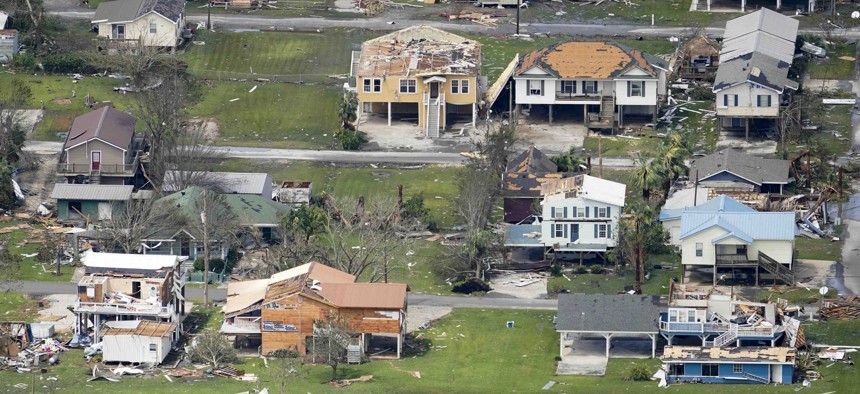Updated Building Codes Prevent Billions in Disaster Damages. Many Localities Don’t Have Them in Place.

Buildings and homes are damaged in the aftermath of Hurricane Laura Thursday, Aug. 27, 2020, near Lake Charles, La. AP Photo/David J. Phillip
Almost two-thirds of local governments haven’t adopted modern building codes.
Constructing homes and other structures to meet modern building codes has saved billions of dollars in losses from natural disasters like flooding and hurricanes over the past two decades, according to new estimates. But many local governments are behind getting these standards in place.
Research that the Federal Emergency Management Agency released late last month looked at a database of about 18 million buildings constructed between 2000 and 2016 and found that cities and counties with modern building codes avoided around $27 billion of estimated losses from natural disasters over those years, compared to places that didn’t have updated codes.
But FEMA also says that 65% of counties, cities and towns across the country have not yet adopted modern building codes. Meanwhile, an estimated 30% of new construction is happening in places with either no building codes or codes that are more than 20 years old.
"The loss-avoidance benefits are huge,” said Gabe Maser, vice president of government relations at the International Code Council. “But as positive as that is, so much has been left on the table because we're continuing to build to outdated standards, or communities that are facing hazard risks are not adopting hazard-resistant codes.”
Avoided property losses from 2000 to 2040 as a result of having the newer codes in place could total $132 billion, according to projections in FEMA’s report.
The requirements in these codes guide things like how elevated a house must be compared to expected flood levels, how roofs must be built to withstand high winds, or standards for windows that can guard against storm-blown debris. In earthquake-prone areas, modern codes include provisions meant to prevent buildings from failing in dangerous ways when they shake.
Maser said, based on what the Code Council hears from building departments, a common reason local governments don’t modernize their codes is a lack of staff time, training and resources. Local officials can also sometimes face pushback from the construction industry and others who would be affected by the rule changes.
Housing affordability is another concern. But Maser points to multiple studies that have shown building to modern code requirements does not make housing significantly more expensive.
Building codes apply to new construction. They can also come up when a homeowner is making repairs or renovations that require building permits, like replacing a damaged roof after a hurricane.
Debate over climate change, especially when it has to do with energy production and limiting emissions, often breaks along party lines.
“Resiliency” initiatives on the other hand—focused on upgrading infrastructure to better handle severe weather and limiting damage to homes and other property from natural disasters—have garnered bipartisan support over the past couple of years.
Building codes are something that can fall into this category.
FEMA’s Building Resilient Infrastructure and Communities program, which stems from bipartisan legislation Congress passed in 2018, promises to provide opportunities for new federal funding for updating and enforcing the codes. And based on the program’s guidelines, places seeking grants for other projects are likely to be more competitive if they have modern codes in place.
The new FEMA report notes that since 1980 the nation has sustained over $1.6 trillion in losses from natural disasters. It adds that these losses have trended upwards during that time as weather-related disasters have become more frequent and severe and as the number of people living in areas that are at risk of natural disasters has grown.
Maser said that adopting and enforcing modern building codes is one of the single most effective tactics that communities can embrace to protect against these losses. “If we don't take these steps now,” he said, “how are we going to fund the consequences later?”
More on FEMA’s study can be found here.
Bill Lucia is a senior reporter for Route Fifty and is based in Olympia, Washington.
NEXT STORY: With New Funding Elusive, a Governor Turns to Planning to Address Flood Hazards






